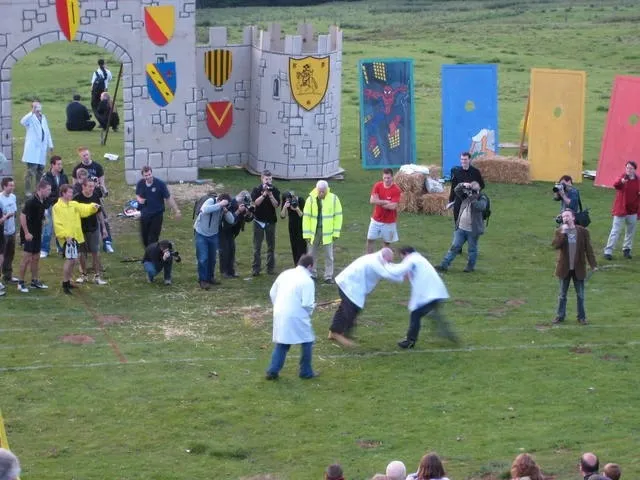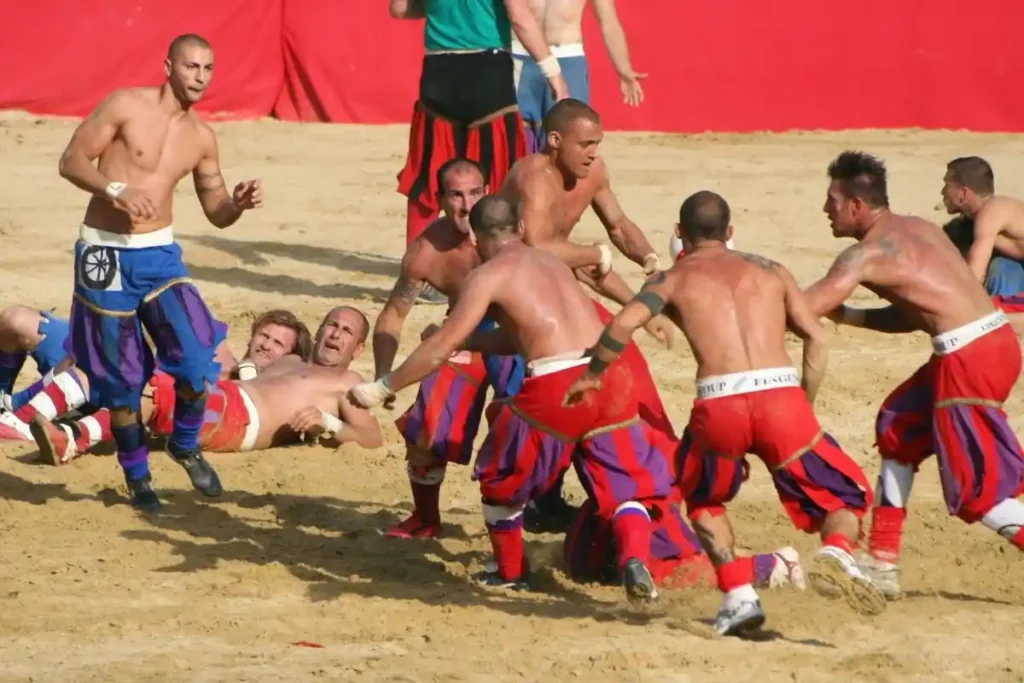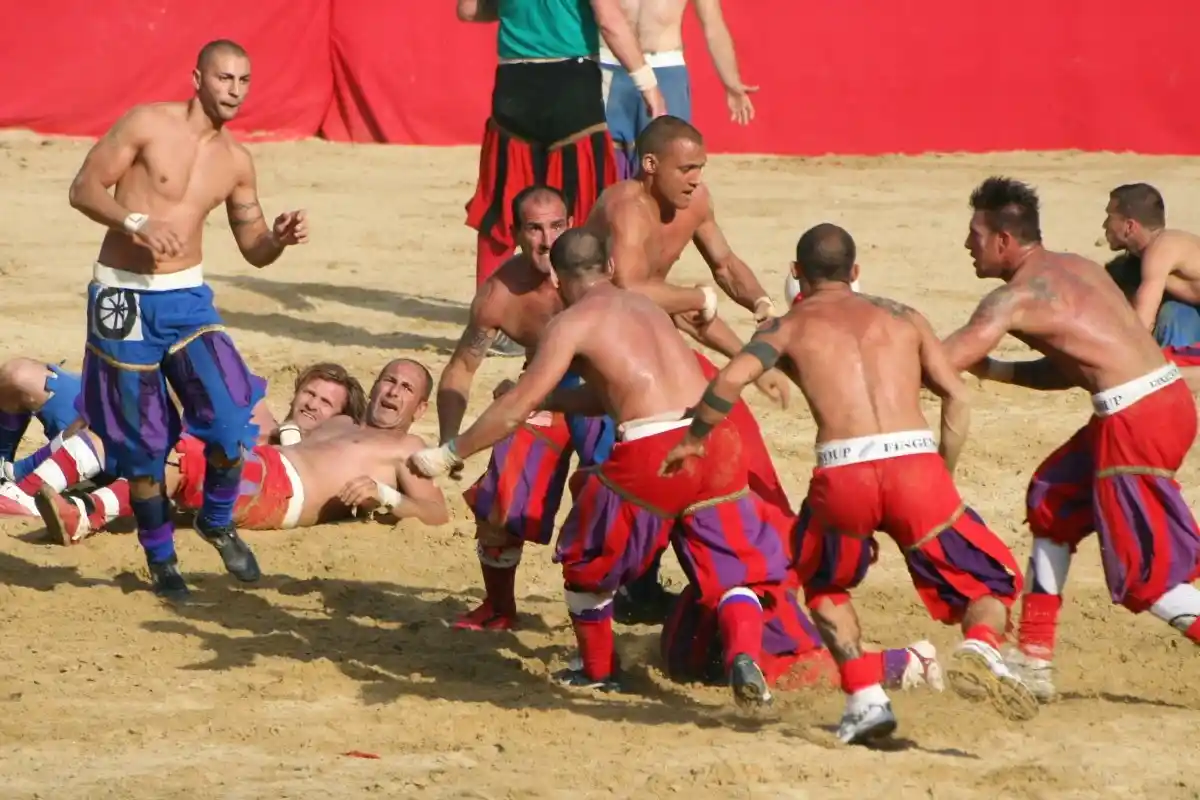Why These Sports Capture Global Attention
While millions tune in to watch football, basketball, and tennis, there’s a captivating underworld of sports that push the boundaries of what we consider “normal” athletic competition. These unconventional games range from daredevil competitions to quirky local traditions, each offering a unique glimpse into the creative spirit of human competition. From ancient battlefields to modern mountains, these bizarre sports prove that the human desire to compete knows no bounds—and sometimes, no logic either.
Here are 5 bizarre sports people really play around the world:
1. Cheese Rolling
The Ultimate Downhill Dash

Picture this: hundreds of spectators gathered on a dangerously steep hill, watching brave (or foolish) participants chase a 9-pound wheel of cheese down a near-vertical slope at breakneck speeds reaching up to 70 mph. Welcome to the Cooper’s Hill Cheese-Rolling and Wake, held annually in Gloucestershire, England—a tradition that’s been rolling along for over 600 years.
The concept sounds simple enough: competitors race down the hill chasing a Double Gloucester cheese wheel, and whoever crosses the finish line first wins the cheese. Reality? Most participants spend more time tumbling, bouncing, and careening out of control than actually running.
Mind-Blowing Facts About Cheese Rolling
- Injury rate is astronomical: Medical teams treat an average of 15-20 injuries each year, ranging from broken bones to concussions
- The cheese reaches speeds faster than the runners: The wheel often hits 70 mph while humans max out around 20-30 mph on the steep terrain
- International participation: Despite being a British tradition, competitors travel from countries like Japan, Australia, and the United States to participate
- The hill’s gradient is 70 degrees: That’s nearly impossible to run down safely—most people end up in an uncontrolled tumble within seconds
- Prize worth: Winners take home the actual cheese wheel, valued at approximately £100 ($125 USD)
2. Extreme Ironing
Adventure Meets Household Chores

What happens when you combine the mundane task of ironing clothes with extreme outdoor adventures? You get Extreme Ironing—a sport where participants take ironing boards to remote, dangerous, or unusual locations to press clothing while navigating challenging environments.
Founded in 1997 by British knitwear factory worker Phil Shaw, this sport has evolved into a legitimate competitive activity with world championships, national teams, and official governing bodies. Extreme ironers have pressed shirts while mountain climbing, underwater diving, parachuting, and even on top of active volcanoes.
Fascinating Extreme Ironing Highlights
- Official world record: Set at 5,440 meters above sea level on Mount Everest, where climbers actually stopped to iron a shirt during their ascent
- Underwater category exists: Divers use specially waterproofed equipment and weighted irons to press clothes on the ocean floor
- Team Germany dominance: Holds multiple world championship titles and treats extreme ironing with the same seriousness as traditional Olympic sports
- Equipment regulations: Official competitions require standard domestic irons and ironing boards—no modified gear allowed
- Global participation: Over 30 countries now have registered extreme ironing communities and compete internationally
3. Shin Kicking
Ancient Combat Sport Disguised as Folk Fun

Don’t let the quaint English countryside setting fool you—shin kicking is a legitimate combat sport that dates back over 400 years to the Cotswold Olympics. Participants grab each other by the shoulders and attempt to kick their opponent’s shins until one person falls to the ground, all while wearing traditional white coats and straw-stuffed trousers.
What started as training for bare-knuckle boxing has evolved into its own championship event, complete with referees called “sticklers” who ensure fair play. The sport requires genuine skill, strategy, and an impressively high pain tolerance.
Brutal Shin Kicking Realities
- Padding is mandatory but limited: Competitors stuff straw down their trouser legs for protection, but serious bruising and injuries are common
- Championship prize: Winners receive a silver trophy and the title of “World Shin Kicking Champion”
- Three-fall system: Matches are decided by the best of three falls, similar to wrestling competitions
- Training techniques: Serious competitors condition their shins by hitting them with hammers and sticks to build pain tolerance
- Female participation growing: Women’s divisions have been added in recent years, with female competitors showing equal determination and skill
4. Wife Carrying
Nordic Romance Meets Athletic Endurance

Before you raise an eyebrow, Wife Carrying (or “Eukonkanto” in Finnish) is a celebrated sport with world championships, strict regulations, and serious prize money. Originating in Finland, the sport involves male competitors racing through a 253.5-meter obstacle course while carrying a female teammate on their backs.
The tradition supposedly stems from historical practices where men would steal women from neighboring villages, but modern competitions focus on teamwork, athletic ability, and surprisingly strategic technique. The most successful carrying method? The “Estonian carry,” where the woman hangs upside-down with her legs around the man’s shoulders.
Wife Carrying Championship Insights
- Prize worth competing for: Winners at the World Championships in Finland receive the woman’s weight in beer plus significant cash prizes
- No marriage requirement: Despite the name, couples don’t need to be married—any female over 17 years old and weighing at least 49 kilograms can participate
- International expansion: Over 60 countries now hold official wife carrying competitions, including the United States, Australia, and Estonia
- World record time: Currently stands at 47.7 seconds, set by Lithuanian couple Vytautas Kirkliauskas and Neringa Kirkliauskiene
- Technique matters more than strength: The most successful teams focus on the woman’s ability to hold her position and the man’s efficient running form rather than pure carrying power
5. Calcio Storico
Medieval Football Meets Modern MMA

Calcio Storico originated during the Middle Ages in Italy and combines football, rugby, and wrestling, played in historical costumes. Held annually in Florence’s Piazza Santa Croce, this sport makes modern football look like a gentle garden party. Fighting is a key element—punching, elbowing, and martial arts are allowed, though kicks to the head are forbidden.
The annual games represent something more than blood and sweat—they’re part football, part fighting, part historical recreation that connects modern Florence to its medieval roots. Teams representing different neighborhoods battle for 50 minutes in what many consider the world’s most violent sport.
Calcio Storico’s Intense Reality
- Zero protective equipment: Players compete in Renaissance-era costumes with no padding, helmets, or safety gear whatsoever
- Minimal rules: Fights of two or more against one are forbidden, but individual combat is not only allowed but expected
- Ancient tradition: Games have been played for over 500 years, with historical records showing matches even during medieval sieges of Florence
- Neighborhood pride: Four teams represent historic Florence districts (Santa Croce, Santa Maria Novella, Santo Spirito, and San Giovanni), creating intense local rivalries
- Professional preparation: Despite its historical nature, modern players train year-round like professional athletes, combining MMA techniques with traditional football skills
Why These Sports Matter More Than You Think
These bizarre competitions remind us that sport isn’t just about winning medals or breaking records—it’s about human creativity, cultural identity, and the irrepressible urge to turn almost anything into a competition. Whether it’s chasing cheese down a hill or ironing shirts on mountain peaks, these sports celebrate the wonderfully weird ways people find to challenge themselves and connect with their communities.
Each of these unusual sports has survived and thrived because they offer something mainstream athletics often can’t: authentic local culture, genuine unpredictability, and the kind of pure, unfiltered fun that makes you question why we don’t chase more cheese wheels in our daily lives.

